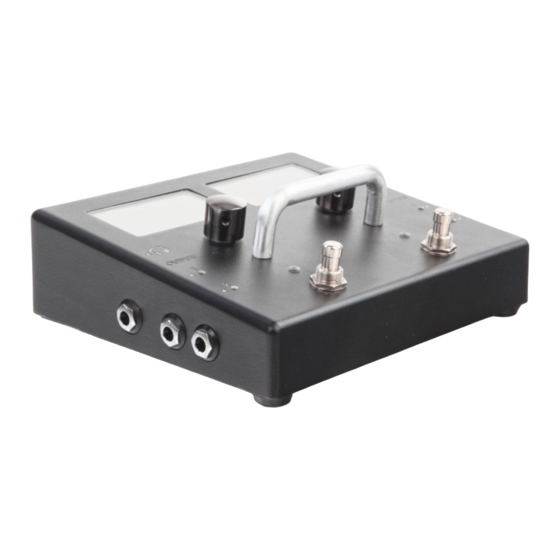
Table of Contents
Advertisement
Quick Links
Download this manual
See also:
User Manual
Advertisement
Table of Contents

Summary of Contents for Mod Duo
- Page 1 MOD Duo User Guide From MOD Wiki This first chapter describes the MOD Duo in high detail. You will find information about the physical device, the device menu and how to control it, and how to hook up the device in your setup.
-
Page 2: Table Of Contents
7 Editing 7.1 Accessing the graphical interface 7.2 Accessing via USB cable 7.3 Accessing via Bluetooth 8 Getting Device Information 9 True Bypass 10 Hooking up the MOD Duo 10.1 Wiring examples 10.1.1 Guitar 10.1.2 Vocals 10.1.3 Keys 10.1.4 MIDI... -
Page 3: Warnings
When inserting the USB-B cable into the MOD Duo, make sure that you are not accidentally plugging it into the Control Chain socket, this can cause a short-circuit. Don't connect the MOD Duo's Control Chain port to a regular Ethernet port, it uses a very different protocol, and may damage your MOD Duo. -
Page 4: Device Features
Turn on the MOD Duo by plugging in its power adapter Wait until the MOD Duo boots up Inputs jacks The MOD Duo has two independant audio inputs, with configurable input gain for each input. You can set up the input gain through the device menu. -
Page 5: Output Jacks
USB computer port This port is mostly used to connect the MOD Duo to your PC for setting it up. When executing a manual system update, its use changes to a mass-storage device, so that you can copy the update-file to the MOD Duo. -
Page 6: General Knob Actions
Press the right footswitch to load the next pedalboard in the active bank Displays The MOD Duo sports two large (2.8") LCD displays. The displays normally give dynamic information about the actions mapped to the device actuators, but they are also used for displaying the device menu and tuner. -
Page 7: Adjusting Volumes
Adjusting Volumes The MOD Duo allows each input and output volume to be individually adjusted. To access the Volume and Gains menu, first press and hold the left knob for one second. The SETTINGS menu will show up, now turn the left knob to select the Volume and Gains option and finally short press the knob to access it. -
Page 8: Outputs
Simply short press the knob to return to the previous menu. Outputs The Output menu has only one option, which allows you to adjust the attenuation of the respective output. Turn the knob to adjust the value. To return to the previous menu simply short press the knob. -
Page 9: Tuning
To exit the tuner press and hold the right knob for one second. If you see a question mark on the tuner screen, it means the MOD Duo is not receiving any input. To tune a guitar, play an unfretted note on a string and tune it until you see the correct note on the display. -
Page 10: Playing
Playing After you have powered on and adjusted the volumes of your MOD Duo, it is ready for playtime. The MOD Duo comes with many pedalboards ready to be used. They are organised in banks and can be accessed via SETTINGS menu. -
Page 11: Editing
Editing Accessing the graphical interface The MOD Duo has a built-in graphical user interface (GUI), which means you don’t need to download any extra software in order to configure the device. To access the interface, you only need a web browser, such as Chrome, Safari or Firefox. -
Page 12: Accessing Via Usb Cable
Getting Device Information This section serves to give you information about the services running, the versions of the different pieces of software running on your MOD Duo, as well as the serial number attached to your MOD Duo. Press and hold the left knob for one second to open the SETTINGS menu, turn the knob to select the Info option and short press the knob to access the Info menu. -
Page 13: True Bypass
The MOD Duo has a true bypass circuit for each pair of input/output. This allows you to physically connect input 1 to output 1, and input 2 to output 2. The true bypass is enabled when the MOD Duo is off and it is automatically disabled after the current pedalboard is loaded. -
Page 14: Wiring Examples
For the first scenario, the only connection that you need to make is from the USB B port on the MOD Duo to your computer. (Bluetooth is possible in case that is preferred) For the second scenario, it is possible to remove the connection to the computer completely, the... - Page 15 This page was last edited on 22 August 2018, at 11:52. Content is available under GNU Free Documentation License 1.3 or later unless otherwise noted.


Need help?
Do you have a question about the Duo and is the answer not in the manual?
Questions and answers